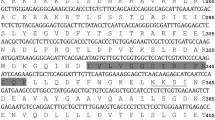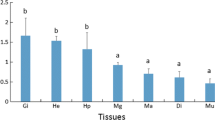Abstract
Small heat shock proteins (sHSPs) encompass a widespread and diverse class of proteins with molecular chaperone activity. In the present study, two sHSP isoforms (VpsHSP-1 and VpsHSP-2) were cloned from Venerupis philippinarum haemocytes by Rapid Amplification of cDNA Ends (RACE) approaches. The expression profiles of these two genes under Vibrio anguillarum challenge and cadmium exposure were investigated by quantitative real-time reverse transcriptase polymerase chain reaction. The bacterial challenge could significantly up-regulate the mRNA expression of both VpsHSP-1 and VpsHSP-2, with the increase of VpsHSP-2 expression occurred earlier than that of VpsHSP-1. During the cadmium exposure experiment, the expression level of both VpsHSP-1 and VpsHSP-2 decreased significantly with larger amplitude in VpsHSP-2. As time progressed, the expression levels of both genes were up-regulated with more increment in the low-chemical exposure groups. The differences in the response to pathogen stimulation and cadmium exposure indicated that there were functional diversity between the two structurally different molecules, VpsHSP-1 and VpsHSP-2, and they probably played distinct roles in mediating the environmental stress and immune responses in calm.






Similar content being viewed by others
References
Gao Q, Song L, Ni D, Wu L, Zhang H, Chang Y (2007) cDNA cloning and mRNA expression of heat shock protein 90 gene in the haemocytes of Zhikong scallop Chlamys farreri. Comp Biochem Physiol 147B:704–715
Haslbeck M (2002) sHsps and their role in the chaperone network. Cell Mol Life Sci 59:1649–1657
Hickman-Miller HD, Hildebrand WH (2004) The immune response under stress: the role of HSP-derived peptides. Trends Immunol 25:427–433
Huang P, Kang S, Chen W, Hsu T, Lo C, Liu K, Chen L (2008) Identification of the small heat shock protein, HSP21, of shrimp Penaeus monodon and the gene expression of HSP21 is inactivated after white spot syndrome virus (WSSV) infection. Fish Shellfish Immunol 25:250–257
Kumar S, Tamura K, Nei M (2004) MEGA3: integrated software for molecular evolutionary genetics analysis and sequence alignment. Brief Bioinform 5:150–163
Li Z, Menoret A, Srivastava P (2002) Roles of heat-shock proteins in antigen presentation and cross-presentation. Curr Opin Immunol 14:45–51
Li C, Sun H, Chen A, Ning X, Wu H, Qin S, Xue Q, Zhao J (2009) Identification and characterization of an intracellular Cu, Zn-superoxide dismutase (icCu/Zn-SOD) gene from clam Venerupis philippinarum. Fish Shellfish Immunol. doi:10.1016/j.fsi.2009.11.021
Lindquist S, Craig EA (1988) The heat-shock proteins. Annu Rev Genet 22:631–677
Mehlen P, Schulze-Osthoff K, Arrigo AP (1996) Small stress proteins as novel regulators of apoptosis. J Biol Chem 271:16510–16514
Mizrahi T, Heller J, Goldenberg S, Arad Z (2009) Heat shock proteins and resistance to desiccation in congeneric land snails. Cell Stress Chaperon. doi:10.1007/s12192-009-0150-9
Morrow G, Inaguma Y, Kato K, Anguay RM T (2000) The small heat shock protein hsp22 of Drosophila melanogaster is a mitochondrial protein displaying oligomeric organization. J Biol Chem 275:31204–31210
Moseley P (2000) Stress proteins and the immune response. Immunopharmacology 48:299–302
Oshita SE, Chen F, Kwan T, Yehiely F, Cryns VL (2010) The small heat shock protein HspB2 is a novel anti-apoptotic protein that inhibits apical caspase activation in the extrinsic apoptotic pathway. Breast Cancer Res Treat. doi:10.1007/s10549-010-0735-0
Pockley AG (2003) Heat shock proteins as regulators of the immune response. Lancet 362:469–476
Pomerai D (1996) Heat-shock proteins as biomarkers of pollution. Hum Exp Toxicol 15:279–285
Solé M, Morcillo Y, Porte C (2000) Stress-protein response in tributyltin-exposed clams. Bull Environ Contam Toxicol 64:852–858
Sørensen JG, Kristensen TN, Loeschcke V (2003) The evolutionary and ecological role of heat shock proteins. Ecol Lett 6:1025–1037
Song L, Wu L, Ni D, Chang Y, Xu W, Xing K (2006) The cDNA cloning and mRNA expression of heat shock protein 70 gene in the haemocytes of bay scallop (Argopecten irradians, Lamarck 1819) responding to bacteria challenge and naphthalin stress. Fish Shellfish Immunol 21:335–345
Srivastava PK (2002) Role of heat-shock proteins in innate and adaptive immunity. Nat Rev Immunol 2:185–194
Thomas X, Campos L, Le Q, Guyotat D (2005) Heat shock proteins and acute leukemias. Hematology 10:225–235
Tsan MF, Gao B (2004a) Heat shock protein and innate immunity. Cell Mol Immunol 1:274–279
Tsan MF, Gao B (2004b) Cytokine function of heat shock proteins. Am J Physiol 286:C739–C744
Tsvetkova NM, Horváth I, Zs T, Wolkers WF, Balogi Z, Shigapova N, Crowe LM, Tablin F, Vierling E, Crowe JH, Vígh L (2002) Small heat-shock proteins regulate membrane lipid polymorphism. Proc Natl Acad Sci USA 99:13504–13509
Wallin RP, Lundqvist A, More SH, Bonin A, Kiessling R, Ljunggren HG (2002) Heat shock proteins as activators of the innate immune system. Trends Immunol 23:l30–135
Woolfson JP, Heikkila JJ (2009) Examination of cadmium-induced expression of the small heat shock protein gene, hsp30, in Xenopus laevis A6 kidney epithelial cells. Comp Biochem Physiol 152A:91–99
Zhang L, Wang L, Song L, Zhao J, Qiu L, Dong C, Li F, Zhang H, Yang G (2009a) The involvement of HSP22 from bay scallop Argopecten irradians in response to heavy metal stress. Mol Biol Rep. doi:10.1007/s11033-009-9603-6
Zhang L, Wang L, Zhao J, Qiu L, Song L, Dong C, Li F (2009b) The responsive expression of heat shock protein 22 gene in Zhikong scallop Chlamys farreri against a bacterial challenge. Aquac Res 41:257–266
Acknowledgements
The project was supported by the Key Laboratory of Experimental Marine Biology (Institute of Oceanology, CAS) and Chinese Academy of Sciences Innovation Program (kzcx2-yw-225, KZCX2-YW-Q07-04), and grants from NSFC (30901115) and SDSFC (ZR2009CZ008).
Author information
Authors and Affiliations
Corresponding author
Rights and permissions
About this article
Cite this article
Li, C., Wang, L., Ning, X. et al. Identification of two small heat shock proteins with different response profile to cadmium and pathogen stresses in Venerupis philippinarum . Cell Stress and Chaperones 15, 897–904 (2010). https://doi.org/10.1007/s12192-010-0198-6
Received:
Revised:
Accepted:
Published:
Issue Date:
DOI: https://doi.org/10.1007/s12192-010-0198-6




